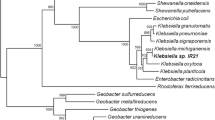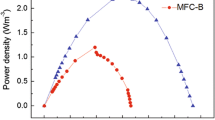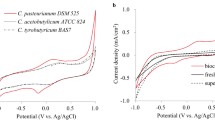Abstract
A Clostridium beijerinckii mutant M13 was derived from C. beijerinckii NCIMB 8052 by atmospheric pressure glow discharge. C. beijerinckii M13 generated a maximum output power density of 79.2 mW m−2 and a maximum output voltage of 230 mV in a microbial fuel cell containing 1 g glucose l−1 as carbon source and 0.15 g methyl viologen l−1 as an electron carrier.



Similar content being viewed by others
References
Allen RM, Bennetto HR (1993) Microbial fuel-cell: electricity production from carbohydrates. Appl Biochem Biotech 39:27–40
Choi Y, Kim N, Kim S, Jung S (2003) Dynamic behaviors of redox mediators within the hydrophobic layers as an important factor for effective microbial fuel cell operation. Bull Korean Chem Soc 24:437–440
Finch AS, Mackie TD, Sund CJ, Sumner JJ (2011) Metabolite analysis of Clostridium acetobutylicum: fermentation in a microbial fuel cell. Biores Technol 102:312–315
Guo T, Tang Y, Xi YL, He AY, Sun BJ, Wu H, Liang DF, Jiang M, Ouyang PK (2011) Clostridium beijerinckii mutant obtained by atmospheric pressure glow discharge producing high proportions of butanol and solvent yields. Biotechnol Lett 33:2379–2383
Guo T, Sun BJ, Jiang M, Wu H, Du TF, Tang Y, Wei P, Ouyang PK (2012a) Enhancement of butanol production and reducing power using a two-stage controlled-pH strategy in batch culture of Clostridium acetobutylicum XY16. World J Microbiol Biotechnol 28:2551–2558
Guo T, Tang Y, Zhang QY, Du TF, Liang DF, Jiang M, Ouyang PK (2012b) Clostridium beijerinckii mutant with high inhibitor tolerance obtained by low-energy ion implantation. J Ind Microbiol Biotechnol 39:401–407
Jang YS, Malaviya A, Lee SY (2013) Acetone-butanol-ethanol production with high productivity using Clostridium acetobutylicum BKM19. Biotechnol Bioeng 110:1646–1653
Liu D, Chen Y, Ying HJ (2013) Enhanced butanol production by modulation of electron flow in Clostridium acetobutylicum B3 immobilized by surface adsorption. Biores Technol 129:321–328
Logan BE, Regan JM (2006) Microbial Fuel-Cell-challenges and applications. Environ Sci Technol 40:5172–5180
Mathuriya AS, Sharma VN (2009) Bioelectricity production from paper industry waste using a microbial fuel cell by Clostridium species. J Biochem Tech 1:49–52
Niessen J, Schröder U, Scholz F (2004) Exploiting complex carbohydrates for microbial electricity generation: a bacterial fuel cell operating on starch. Electrochem Commun 6:955–958
Peguin S, Soucaille P (1995) Modulation of carbon and electron flow in Clostridium acetobutylicum by iron limitation and methyl viologen addition. Appl Environ Microbiol 61:403–405
Peguin S, Soucaille P (1996) Modulation of metabolism of Clostridium acetobutylicium grown in chemostat culture in a three-electrode potentiostatic system with methyl viologen as electron carrier. Biotechnol Bioeng 51:342–348
Peguin S, Goma G, Delorme P, Soucaille P (1994) Metabolic flexibility of Clostridium acetobutylicum in response to methyl viologen addition. Appl Microbiol Biotechnol 42:611–616
Song TS, Wu XY, Zhou CC (2014) Effect of different acclimation methods on the performance of microbial fuel cells using phenol as substrate. Bioproc Biosyst Eng 37:133–138
Sridhar J, Eiteman MA (2001) Metabolic flux analysis of Clostridium thermosuccinogenes effect of pH and culture redox potential. Appl Biochem Biotechnol 94:51–69
Sund C, McMasters S, Crittenden S, Harrell L, Sumner J (2007) Effect of electron mediators on current generation and fermentation in a microbial fuel cell. Appl Microbiol Biotechnol 76:561–568
Thorneley RNF (1974) A convenient electrochemical preparation of reduced methyl viologen and a kinetic study of the reaction with oxygen using an anaerobic stopped-flow apparatus. Biochim Biophys Acta 333:487–496
Wang SH, Zhu Y, Zhang YP, Li Y (2012) Controlling the oxidoreduction potential of the culture of Clostridium acetobutylicium leads to an earlier initiation of solventogenesis, thus increasing solvent productivity. Appl Microbiol Biotechnol 93:1021–1030
Wang L, Xia ML, Zhang LH, Chen HZ (2014) Promotion of the Clostridium acetobutylicum ATCC824 growth and acetone-butanol-ethanol fermentation by flavonoids. World J Microbiol Biotechnol 30:1969–1976
Yang YG, Xu MY, Guo J, Sun GP (2012) Bacterial extracellular electron transfer in bioelectrochemical systems. Proc Biochem 47:1707–1714
Yuan SJ, He H, Sheng GP, Chen JJ, Tong ZH, Cheng YY, Li WW, Lin ZQ, Zhang F, Yu HQ (2013) A photometric high-throughput method for identification of electrochemically active bacteria using a WO3 nanocluster probe. Sci Rep 3:1315
Acknowledgments
This work was supported by the National Natural Science Foundation of China (Grant No. 21306032); the Restructured institutions innovation capacity of special funds of Ministry of Science and Technology of China (Grant No. 2014EG111227); the National High-Tech Research and Development Program of China (863) (Grant No. 2012AA021200); the National Basic Research Program of China (973) (Grant No. 2011CBA00806) and Project Funded by the Priority Academic Program Development of Jiangsu Higher Education Institutions (PAPD); Postdoctoral Science Foundation of Jiangsu Province (Grant No. 1302107C).
Author information
Authors and Affiliations
Corresponding author
Additional information
Jun Liu and Ting Guo have contributed equally to this work.
Rights and permissions
About this article
Cite this article
Liu, J., Guo, T., Wang, D. et al. Clostridium beijerinckii mutant obtained atmospheric pressure glow discharge generates enhanced electricity in a microbial fuel cell. Biotechnol Lett 37, 95–100 (2015). https://doi.org/10.1007/s10529-014-1649-4
Received:
Accepted:
Published:
Issue Date:
DOI: https://doi.org/10.1007/s10529-014-1649-4




